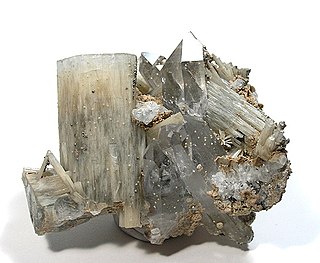
Zinnwaldite, KLiFeAl(AlSi3)O10(OH,F)2, potassium lithium iron aluminium silicate hydroxide fluoride is a silicate mineral in the mica group. The IMA status is as a series between siderophyllite (KFe2Al(Al2Si2)O10(F,OH)2) and polylithionite (KLi2AlSi4O10(F,OH)2) and not considered a valid mineral species.
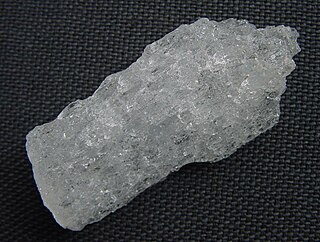
Kalinite is a mineral composed of hydrated potassium aluminium sulfate. It is a fibrous monoclinic alum, distinct from isometric potassium alum, named in 1868. Its name comes from kalium (derived from Arabic: القَلْيَه al-qalyah "plant ashes", which is the Latin name for potassium, hence its chemical symbol, "K".
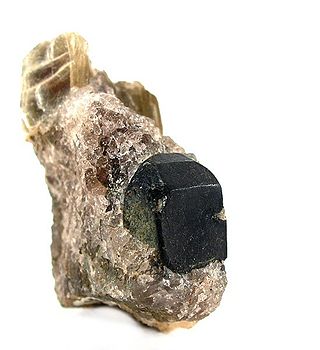
Triphylite is a lithium iron(II) phosphate mineral with the chemical formula LiFePO4. It is a member of the triphylite group and forms a complete solid solution series with the lithium manganese(II) phosphate, lithiophilite. Triphylite crystallizes in the orthorhombic crystal system. It rarely forms prismatic crystals and is more frequently found in hypidiomorphic rock. It is bluish- to greenish-gray in color, but upon alteration becomes brown to black.
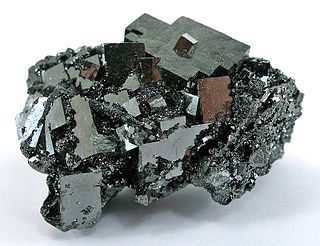
Bixbyite is a manganese iron oxide mineral with chemical formula: (Mn,Fe)2O3. The iron/manganese ratio is quite variable and many specimens have almost no iron. It is a metallic dark black with a Mohs hardness of 6.0 – 6.5. It is a somewhat rare mineral sought after by collectors as it typically forms euhedral isometric crystals exhibiting various cubes, octahedra, and dodecahedra.
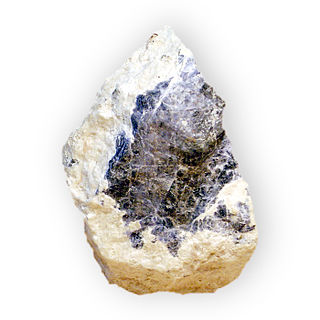
Cancrinite is a complex carbonate and silicate of sodium, calcium and aluminium with the formula Na6Ca2[(CO3)2|Al6Si6O24]·2H2O. It is classed as a member of the feldspathoid group of minerals; the alkali feldspars that are poor in silica. Yellow, orange, pink, white or even blue, it has a vitreous or pearly luster; a hardness of 5–6 and an uneven conchoidal fracture. It is unusual among the silicate minerals in that it will effervesce with hydrochloric acid due to the associated carbonate ions.

Calderite is a mineral in the garnet group with the chemical formula (Mn2+, Ca)3(Fe3+, Al)2(SiO4)3.
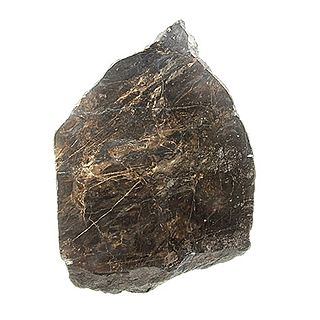
Galaxite, also known as 'mangan-spinel' is an isometric mineral belonging to the spinel group of oxides with the ideal chemical formula Mn2+Al2O4.

Jacobsite is a manganese iron oxide mineral. It is in the spinel group and forms a solid solution series with magnetite. The chemical formula is (Mn,Mg)Fe2O4 or with oxidation states and substitutions: (Mn2+,Fe2+,Mg)(Fe3+,Mn3+)2O4.

Zabuyelite is the natural mineral form of lithium carbonate, with a formula Li2CO3. It was discovered in 1987 at Lake Zabuye, Tibet, after which it is named. It forms colorless vitreous monoclinic crystals.

Zirconolite is a mineral, calcium zirconium titanate; formula CaZrTi2O7. Some examples of the mineral may also contain thorium, uranium, cerium, niobium and iron; the presence of thorium or uranium would make the mineral radioactive. It is black or brown in color.

Agrinierite (chemical formula K2(Ca,Sr)(UO2)3O3(OH)2·5H2O) is a mineral often found in the oxidation zone of uranium deposits. The IMA symbol is Agn. It is named for Henry Agrinier (1928–1971), an engineer for the Commissariat à l'Énergie Atomique.

Neptunite is a silicate mineral with the formula KNa2Li(Fe2+, Mn2+)2Ti2Si8O24. With increasing manganese it forms a series with mangan-neptunite. Watatsumiite is the variety with vanadium replacing the titanium in the formula.
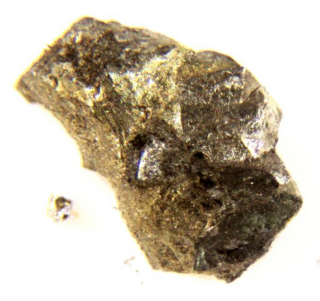
Vulcanite is a rare copper telluride mineral. The mineral has a metallic luster, and has a green or bronze-yellow tint. It has a hardness between 1 and 2 on the Mohs scale. Its crystal structure is orthorhombic.
Brownleeite is a silicide mineral with chemical formula MnSi. It was discovered by researchers of the Johnson Space Center in Houston while analyzing the Pi Puppid particle shower of the comet 26P/Grigg-Skjellerup. The only other known natural manganese silicide is mavlyanovite, Mn5Si3.
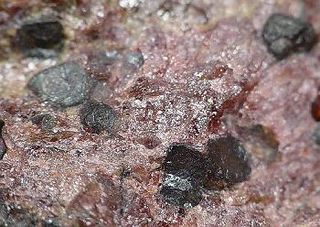
Manganosite is a rare mineral composed of manganese(II) oxide MnO. It was first described in 1817 for an occurrence in the Harz Mountains, Saxony-Anhalt, Germany. It has also been reported from Langban and Nordmark, Sweden and at Franklin Furnace, New Jersey. It also occurs in Japan, Kyrgyzstan and Burkina Faso.
Albrechtschraufite (IMA symbol: Asf) is a very rare complex hydrated calcium and magnesium-bearing uranyl fluoride carbonate mineral with formula Ca4Mg(UO2)2(CO3)6F2·17H2O. Its molar weight is 1,428.98 g, color yellow-green, streak white, density 2.6 g/cm3, Mohs hardness 2–3, and luster is vitreous (glassy). It is named after Albrecht Schrauf (1837–1897), Professor of Mineralogy, University of Vienna. Its type locality is Jáchymov, Jáchymov District, Krušné Hory Mountains, Karlovy Vary Region, Bohemia, Czech Republic.

Aleksite (IMA symbol: Alk) is a rare lead bismuth tellurium sulfosalt mineral with formula PbBi2Te2S2.

Strashimirite is a rare monoclinic mineral containing arsenic, copper, hydrogen, and oxygen. It has the chemical formula Cu8(AsO4)4(OH)4·5(H2O).
Lithiophosphate is a natural form of (pure) lithium orthophosphate. It is an exceedingly rare mineral, occurring in some special types of pegmatites.
















